Pressure is Force per Unit Area
The equation for pressure is the force divided by the area where the force is applied.
- Although this measurement is straightforward when a solid is pushing on a solid,
- the case of a solid pushing on a liquid or gas requires that the fluid be confined in a container. The force can also be created by the weight of an object.
- What is the pressure when a solid pushes on another solid?
- What happens when a solid pushes on a confined fluid?
- What happens when the force comes from gravity?
Pressure of solid on a solid
When you apply a force to a solid object, the pressure is defined as the force applied divided by the area of application. The equation for pressure is:P = F/Awhere
- P is the pressure
- F is the applied force
- A is the surface area where the force is applied
- F/A is F divided by A
20 / 10 = 2 pounds per square inch.

Pressure equals Force divided by Area
- You can see that for a given force, if the surface area is smaller, the pressure will be greater.
- If you use a larger area, you are spreading out the force, and the pressure (or force per unit area) becomes smaller.
Solid pressing on confined fluid
When a liquid or gas is confined in a container or cylinder, you can create a pressure by applying a force with a solid piston. The pressure created in the cylinder equals the force applied divided by the area of the piston: P = F/A.In a confined fluid—neglecting the effect of gravity on the fluid—the pressure is the same throughout the container, pressing equally on all the walls. In the case of a bicycle pump, the pressure created inside the pump will be transmitted through the hose into the bicycle tire. But the air is still all confined.

Pressure is in all directions in a fluid
Increasing the force will increase the pressure inside the cylinder. Caused by gravity
Since the weight of an object is a force caused by gravity, we can substitute weight in the pressure equation. Thus the pressure (P) caused by the weight (W) of an object is that weight divided by the area (A) where the weight is applied.P = W/AIf you place a solid object on the floor, the pressure on the floor over the area of contact is the weight of the object divided by the area on the floor.

Pressure equals Weight divided by Area
Example with shoes
A good example of how a force on small area can result in a very high pressure is seen in women's shoes with high spiked heels. These types of shoes can cause damage to some floors due to the very high pressure on the floor at the heel.An average shoe distributes the weight of the person over 20 square inches. Thus, a 100-pound person applies 100/20 = 5 pounds per square inch on the floor.
Since a spike-heel is only 0.25 square inches, the 100-pound person would be applying 100/0.25 = 400 pounds per square inch on the floor at the heel! In some cases, that is sufficient to damage the floor.
Fluid weight
If you put a liquid in a container, the weight of that liquid would be pressing on the bottom of the container similar to that of the weight of a solid object. The pressure on the bottom of the container would be the same as if the weight was from a solid:P = W/A.The only difference is that pressure in a fluid goes in all directions. So the pressure on the sides at the bottom would be the same.
Gases and liquids exhibit pressure due to their weight at every point in the fluid.
Summary
Pressure is the force on an object that is spread over a surface area. The equation for pressure is P = F/A. Pressure can be measured for a solid is pushing on a solid, but the case of a solid pushing on a liquid or gas requires that the fluid be confined in a container. The force can also be created by the weight of an object.
Put pressure on yourself to excel
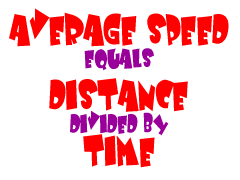 Velocity and speed are very similar ideas, but velocity is a
Velocity and speed are very similar ideas, but velocity is a  There is a special thing called instantaneous velocity.
That's the velocity at a split second in time. Above, we were talking
about your speed and direction over a long period of time. Why would you
need to measure a velocity at one moment? Think about the moment you
drove over the manhole. It's important to know if you were going 1 km/hr
when you drove over the manhole, or 60 km/hr. It wouldn't help you to
know that your average speed was 30 km/hr.
There is a special thing called instantaneous velocity.
That's the velocity at a split second in time. Above, we were talking
about your speed and direction over a long period of time. Why would you
need to measure a velocity at one moment? Think about the moment you
drove over the manhole. It's important to know if you were going 1 km/hr
when you drove over the manhole, or 60 km/hr. It wouldn't help you to
know that your average speed was 30 km/hr.
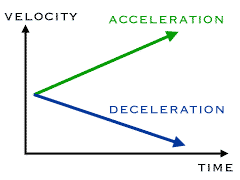 When velocity is changing, the word acceleration is
used. Acceleration is also a vector. You speed up if the acceleration
and velocity point in the same direction. You slow down (also referred
to as decelerating) if the acceleration and velocity
point in opposite directions. When you accelerate or decelerate, you
change your velocity by a specific amount over a specific amount of
time.
When velocity is changing, the word acceleration is
used. Acceleration is also a vector. You speed up if the acceleration
and velocity point in the same direction. You slow down (also referred
to as decelerating) if the acceleration and velocity
point in opposite directions. When you accelerate or decelerate, you
change your velocity by a specific amount over a specific amount of
time.
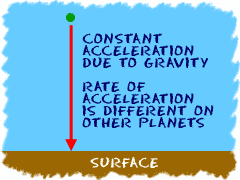 There are a few special situations where acceleration may be constant.
This type of acceleration happens when there is a constant net force
applied. The best example is
There are a few special situations where acceleration may be constant.
This type of acceleration happens when there is a constant net force
applied. The best example is 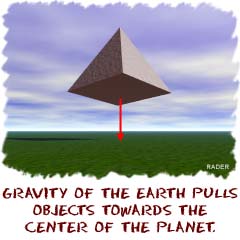 Gravity or gravitational forces are forces of
attraction. We're not talking about finding someone really cute and
adorable. It's like the Earth pulling on you and keeping you on the
ground. That pull is gravity at work.
Gravity or gravitational forces are forces of
attraction. We're not talking about finding someone really cute and
adorable. It's like the Earth pulling on you and keeping you on the
ground. That pull is gravity at work.
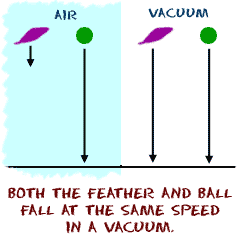 People always say, "What about feathers? They fall so slowly."
Obviously, there is air all around us. When a feather falls, it falls
slowly because the air is in its way. There is a lot of
People always say, "What about feathers? They fall so slowly."
Obviously, there is air all around us. When a feather falls, it falls
slowly because the air is in its way. There is a lot of 







 In the illustration above, there is more pressure at the pointed part of the pin, because that area is tiny and given the same force, the pressure will be more. The pressure at the flat end is less because the area is wider.
In the illustration above, there is more pressure at the pointed part of the pin, because that area is tiny and given the same force, the pressure will be more. The pressure at the flat end is less because the area is wider.
 Balanced forces can be demonstrated in Hanging, Floating and Standing/sitting objects
Balanced forces can be demonstrated in Hanging, Floating and Standing/sitting objects
 Consider a metal block resting on a surface of a table. Its' weight is balanced by the reaction force from the surface. The surface pushes up against the metal block, balancing out the weight (force) of the metal block.
Consider a metal block resting on a surface of a table. Its' weight is balanced by the reaction force from the surface. The surface pushes up against the metal block, balancing out the weight (force) of the metal block.






 Kinetic and potential energies are found in all objects. If an object is moving, it is said to have kinetic energy (KE). Potential energy
(PE) is energy that is "stored" because of the position and/or
arrangement of the object. The classic example of potential energy is to
pick up a brick. When it's on the ground, the brick had a certain
amount of energy. When you pick it up, you apply force and lift the
object. You did
Kinetic and potential energies are found in all objects. If an object is moving, it is said to have kinetic energy (KE). Potential energy
(PE) is energy that is "stored" because of the position and/or
arrangement of the object. The classic example of potential energy is to
pick up a brick. When it's on the ground, the brick had a certain
amount of energy. When you pick it up, you apply force and lift the
object. You did 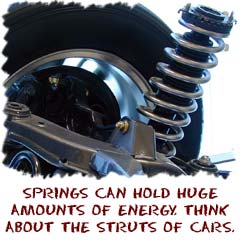 A rubber band can be stretched and then it is ready to do something.
That stretching involves work and increases the potential energy. You
can flatten a solid rubber ball and it will want to bounce back up. You
can also pull the drawstring of a bow and the work done stores the
energy that can make the arrow go flying. Those are all examples of your
putting energy in, and then something happening when the energy comes
out.
A rubber band can be stretched and then it is ready to do something.
That stretching involves work and increases the potential energy. You
can flatten a solid rubber ball and it will want to bounce back up. You
can also pull the drawstring of a bow and the work done stores the
energy that can make the arrow go flying. Those are all examples of your
putting energy in, and then something happening when the energy comes
out.